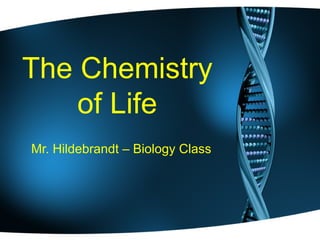The Chemistry of Life
•
23 gefällt mir•13,009 views
This slideshow is intended for students in Mr. Hildebrandt's biology classes.
Melden
Teilen
Melden
Teilen

Empfohlen
Weitere ähnliche Inhalte
Was ist angesagt?
Was ist angesagt? (20)
Properties and Formation of Ionic Compounds Powerpoint

Properties and Formation of Ionic Compounds Powerpoint
Atomic number, Mass number, Relative atomic mass and Atomic mass unit

Atomic number, Mass number, Relative atomic mass and Atomic mass unit
Ähnlich wie The Chemistry of Life
Ähnlich wie The Chemistry of Life (20)
Carbon Chemistry and Applications - Gurumurthy B R

Carbon Chemistry and Applications - Gurumurthy B R
Mehr von Shakopee Public Schools
Mehr von Shakopee Public Schools (20)
The Chemistry of Life
- 1. The Chemistry of Life Mr. Hildebrandt – Biology Class
- 2. Important Terms • Matter – anything physical that takes up space • Mass – the amount of matter • Atom – basic unit of matter • Element – simplest form of matter • Combining Power – number of atoms an element can bond to • Compound – atoms of 2 or more elements held together by bonds
- 3. Chemical Bonds • Ionic bond – oppositely charged atoms are joined • Covalent bond – atoms joined by sharing electrons or “valences” A. Single: share 1 pair of electrons B. Double: share 2 pair C. Triple: share 3 pair
- 4. Polyatomic Compounds There are two types of compounds: • Inorganic (non-living) - do not contain the element Carbon • Organic – (living) do contain Carbon
- 5. The “C.H.O.N. Compounds” • Organic compounds that contain Carbon, Hydrogen, Oxygen & Nitrogen • Living organisms require four types for survival:
- 6. 1. Carbohydrates • Provide energy • Monosaccharides (simple sugars) are the building blocks • Disaccharides and Polysaccharides commonly exist
- 7. 2. Lipids • Provides energy storage • 8 categories including fats, waxes, & some vitamins (A,D,E,K)
- 8. 3. Proteins • Each unique protein performs specific duties • Some are enzymes (speed up reactions) • Smaller amino acids are the building blocks
- 9. 4. Nucleic Acids • Stores all genetic information • Two main types: DNA & RNA • Nucleotides are building blocks
